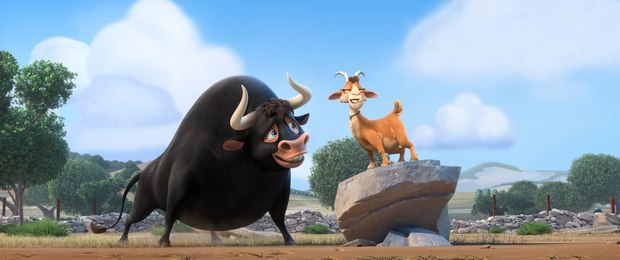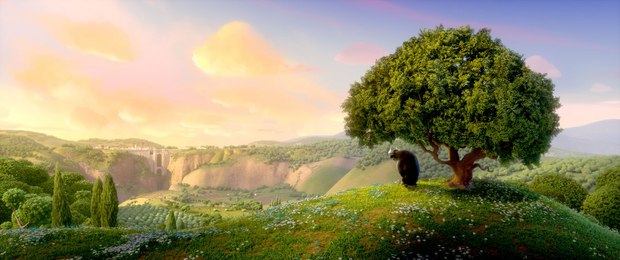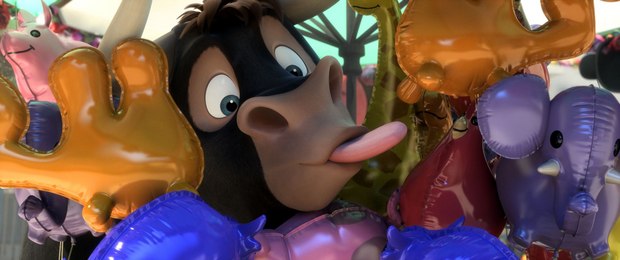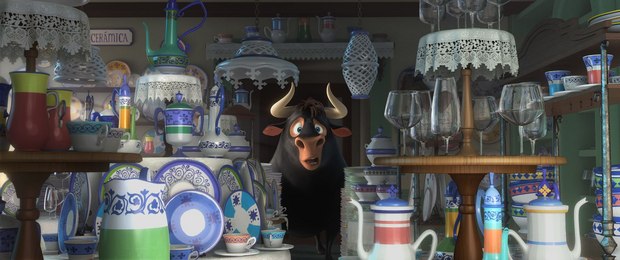Oscar-nominated director of Blue Sky Studios and 20th Century Fox’s ‘Ice Age’ and ‘Rio” franchises details the six-year journey adapting the beloved story of the giant bull who prefers flowers to fighting into a full-length feature film.
Newly arrived in theaters, Blue Sky Studios and 20th Century Fox’s CG-animated feature Ferdinand adapts the beloved story of the giant bull who prefers flowers to fighting that has captured the hearts of millions since it was first told in the 1936 book “The Story of Ferdinand” by author Munro Leaf and illustrator Robert Lawson.
The pacifist tale was first adapted for the big screen by Walt Disney in his 1938 Oscar-winning short, Ferdinand the Bull, with Disney himself voicing the role of Ferdinand’s mother. But now, Carlos Saldanha, the Academy Award-nominated creator and director of the Rio series and director of many of the Ice Age movies, has expanded the simple story to include a cast of vibrant characters set against a gorgeously rendered backdrop of sun-drenched Spain.
Ferdinand centers on the adventures of a peace-loving bull (voiced by John Cena), who is adopted as a pet by a kindly farmer and adoring his daughter. However, Ferdinand’s idyllic life changes after he’s mistaken for a vicious beast and is taken away to the last place on earth he wants to be, a bull training camp. But Ferdinand is determined to get back home. Along the way, the kind-hearted bull makes many friends and changes the lives of those he meets. But there still one great obstacle he’ll have to overcome: in the film’s thrilling climactic scene, Ferdinand has to face the matador El Primero in a packed arena, but he valiantly stays true to his peaceful nature, and inspires all those around him.
“The book was little but the message was big,” Saldanha says of his approach to developing the story. “The first thing, before I even engaged in making the movie, was that I wanted to meet the family who owned the rights to the estate. Because I had never adapted anything before! All my previous movies were original ideas that we came up with, and we worked together to do it. This one was a book that was beloved. It carried a lot of weight. At first, I was a little scared about it,” the Brazilian director admits.
“The family gave me the freedom to really create the movie that I wanted to create, to pursue a vision or even create a new vision for it,” Saldanha recalls. “I reassured them that one thing I loved about the book was the strong message about empowerment, about peace, about tolerance, about staying true to who you are. And I promised them that I would make sure that comes through in the movie.”
For Saldanha, the biggest question became how to expand that small book into a full-length feature film. “One of the biggest challenges was creating the story surrounding Ferdinand. I really wanted to go beyond what the book had, and try to create new characters, but, as in the book, the core of the story was always from Ferdinand’s point of view, culminating in that classic moment when he sits down and doesn’t fight,” he recounts.
“In a way I started the movie backwards,” Saldanha continues. “This is the first project where I started animating from third act and then into the first act. So, it was an odd process, but I needed to do that because I knew how the book ended and I knew how the movie should end. But that was the biggest challenge. Coming up with all the characters, and type up the story that culminates with that crucial moment in the story.”
The journey to bring Ferdinand to the big screen began more than six years ago, when Saldanha was still working on Rio 2. For producer John Davis (Dr. Doolittle, Garfield), acquiring the rights to the book was a long-held dream. “My kids loved the book,” he says. “It had never been optioned before, so I was really happy and excited to get it. For me, it’s part of my children’s bedtime routine growing up, and it’s brought a kind of really deep emotional resonance and nostalgia for me.”
For Blue Sky Studios producer Lori Forte, who had previously worked with Saldanha on the first three Ice Age movies, Ferdinand provided a welcome opportunity to reunite with the director. “Carlos wanted to be true to the book, but he also needed to open it up. At the same time, he needed to make sure that he was in the same spirit as the book and being honest, telling an honest, true story that could work into the way the book had set it all up,” she says. “It was an intense process, to find the right story, to find the point of view of the story, to find the characters, but once that came together he was in his element.”
Producer Bruce Anderson, who also worked with Saldanha on the two Rio movies, was excited by the opportunity to revisit one of the favorite books of his childhood, as well as the creative challenges that the project presented. “Ferdinand offered Carlos an opportunity to really tell a movie from a very specific perspective that wasn’t necessarily available in the Ice Age or Rio films,” he notes. “The main character in our movie, Ferdinand, really changes others around him. He doesn’t go through the same kind of arc the main characters from Carlos’s past movies have gone through. I think that’s where Carlos’s filmmaking maturity, frankly, really came into form and helped us. For me, it helped us really hit some good high notes on this storytelling side.”
Creating an expanded narrative for Ferdinand was one thing, but framing the story was another. “The first hurdle we had to get across was ‘how do we tell the story?’ Are there humans? Is this a human story, is this a bull story? Is this an animal story, is it animals with humans?” Forte recounts.
“For a long time, there was a lot of discussion about whose point of view is telling this story,” she continues. “We had different versions that we were developing, with humans and animals, and just animals. At a certain point Carlos became very clear that he wanted the story to be from the point of view of Ferdinand the Bull. It’s Ferdinand, after all, and his own personal experiences and what he’s going through. This wonderful bull is trying to be himself in a world that sees him as something other than who he truly is.”
Another daunting task the filmmakers faced was developing a full cast of characters to support the titular bull, including a competitively anxious bull named Guapo (voiced by Peyton Manning) and a “comfort goat” named Lupe (Kate McKinnon). “The process of developing Lupe was really fun,” Saldanha says.
“We wanted to have a character that would be next to Ferdinand through the journey, especially in the second act. We wanted somebody to contrast. And as we looked we looked at references of animals and barn animals, one thing we found is that they sometimes put smaller animals next to the big animals for comfort so they can feel like they have company, companionship. Like a service dog that some people fly with, for example,” he continues.
“We thought that was funny concept, and that’s when the calming goat idea came up. And then wouldn’t it be funny if the goat had a similar issue to Ferdinand? In a way, she was being mislabeled. The world only thinks of her in the role of a calming goat, but she is not calming at all! She’s hysterical, and crazy -- the opposite. And, like Ferdinand, she wants to be something else but she was never given the chance to do that.”
From the idyllic farm sequences to a dramatic confrontation in the bullring with Spain’s most prominent matador, El Primero (Miguel Ángel Silvestre), in the end, Ferdinand is a story about being true to your own nature. “The bigger concern would be that people would think this movie was about bullfighting. It actually was not,” notes Saldanha.
“Bullfighting is part of the story, but it is not the crucial element of Ferdinand’s journey,” he insists. “Ferdinand’s journey is a personal journey to be accepted, to be true to who he is. And the fighting is the antagonistic force. The movie doesn’t have a villain, the El Primero is not a villain which is the matador, he is not a villain. He is an antagonistic force. To Ferdinand’s eyes he is who is going to face off and he is who he is going to have to decide if he wants to fight or not with. And I think that’s the main message.”
















